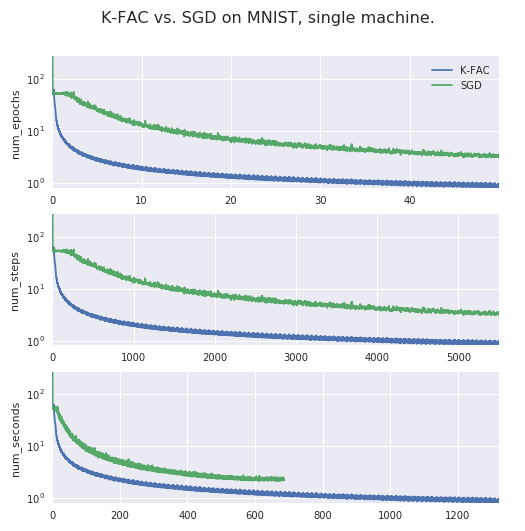K-FAC in TensorFlow is an implementation of K-FAC, an
approximate second-order optimization method, in TensorFlow. When applied to
feedforward and convolutional neural networks, K-FAC can converge >3.5x
faster in >14x fewer iterations than SGD with Momentum.
kfac is compatible with Python 2 and 3 and can be installed directly via
pip,
# Assumes tensorflow or tensorflow-gpu installed
$ pip install kfac
# Installs with tensorflow-gpu requirement
$ pip install 'kfac[tensorflow_gpu]'
# Installs with tensorflow (cpu) requirement
$ pip install 'kfac[tensorflow]'K-FAC, short for "Kronecker-factored Approximate Curvature", is an approximation to the Natural Gradient algorithm designed specifically for neural networks. It maintains a block-diagonal approximation to the Fisher Information matrix, whose inverse preconditions the gradient.
K-FAC can be used in place of SGD, Adam, and other Optimizer implementations.
Experimentally, K-FAC converges >3.5x faster than well-tuned SGD.
Unlike most optimizers, K-FAC exploits structure in the model itself (e.g. "What are the weights for layer i?"). As such, you must add some additional code while constructing your model to use K-FAC.
K-FAC can take advantage of the curvature of the optimization problem, resulting in faster training. For an 8-layer Autoencoder, K-FAC converges to the same loss as SGD with Momentum in 3.8x fewer seconds and 14.7x fewer updates. See how training loss changes as a function of number of epochs, steps, and seconds:
If you have a feedforward or convolutional model for classification that is converging too slowly, K-FAC is for you. K-FAC can be used in your model if:
- Your model defines a posterior distribution.
- Your model uses only fully-connected or convolutional layers (residual connections OK).
- You are training on CPU or GPU.
- You can modify model code to register layers with K-FAC.
Using K-FAC requires three steps:
- Registering layer inputs, weights, and pre-activations with a
LayerCollection. - Minimizing the loss with a
KfacOptimizer. - Keeping K-FAC's preconditioner updated.
# Build model.
w = tf.get_variable("w", ...)
b = tf.get_variable("b", ...)
logits = tf.matmul(x, w) + b
loss = tf.reduce_mean(
tf.nn.softmax_cross_entropy_with_logits(labels=y, logits=logits))
# Register layers.
layer_collection = LayerCollection()
layer_collection.register_fully_connected((w, b), x, logits)
layer_collection.register_categorical_predictive_distribution(logits)
# Construct training ops.
optimizer = KfacOptimizer(..., layer_collection=layer_collection)
_, cov_update_op, _, inv_update_op, _, _ = optimizer.make_ops_and_vars()
train_op = optimizer.minimize(loss)
# Minimize loss.
with tf.Session() as sess:
...
sess.run([train_op, cov_update_op, inv_update_op])See examples/ for runnable, end-to-end illustrations.
- Alok Aggarwal
- Daniel Duckworth
- James Martens
- Matthew Johnson
- Olga Wichrowska
- Roger Grosse

